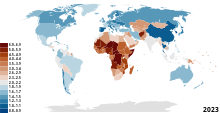
Back خصوبة دون مستوى الإحلال Arabic Fecundidad de reemplazo Spanish باروری زیر سطح جایگزینی Persian Dénatalité French פריון תת-החלפתי HE 少子化 Japanese 저출산 Korean Denataliteit Dutch Desnatalidade Portuguese Рождаемость ниже уровня воспроизводства Russian



Sub-replacement fertility is a total fertility rate (TFR) that (if sustained) leads to each new generation being less populous than the older, previous one in a given area. The United Nations Population Division defines sub-replacement fertility as any rate below approximately 2.1 children born per woman of childbearing age, but the threshold can be as high as 3.4 in some developing countries because of higher mortality rates.[1] Taken globally, the total fertility rate at replacement was 2.33 children per woman in 2003.[1] This can be "translated" as 2 children per woman to replace the parents, plus a "third of a child" to make up for the higher probability of males born and mortality prior to the end of a person's fertile life.[a] In 2020, the global average fertility rate was around 2.4 children born per woman.[2]
Replacement-level fertility in terms of the net reproduction rate (NRR) is exactly one, because the NRR takes both mortality rates and sex ratios at birth into account.
As of 2010, about 48% (3.3 billion people) of the world population lives in nations with sub-replacement fertility.[3] Nonetheless most of these countries still have growing populations due to immigration, population momentum and increase of the life expectancy. This includes most nations of Europe, Canada, Australia, Brazil, Russia, Iran, Tunisia, China, India, the United States and many others. In 2016, all European Union countries had a sub-replacement fertility rate, ranging from a low of 1.3 in Portugal, Poland, Greece, Spain and Cyprus to a high of 2.0 in France.[4] The countries or areas that have the lowest fertility are in developed parts of East and Southeast Asia: Singapore, Hong Kong and South Korea.[4] Only a few countries have had, for the time being, sufficiently sustained sub-replacement fertility (sometimes combined with other population factors like higher emigration than immigration) to have population decline, such as Japan, Germany, Lithuania, and Ukraine. As of 2020, the total fertility rate varied from 0.84 in South Korea[5] to 7.0 in Niger.[6]
- ^ a b Espenshade TJ, Guzman JC, Westoff CF (2003). "The surprising global variation in replacement fertility". Population Research and Policy Review. 22 (5/6): 575–583. doi:10.1023/B:POPU.0000020882.29684.8e. S2CID 10798893., Introduction and Table 1, p. 580
- ^ "Fertility rate, total (births per woman)". The World Bank.
- ^ "Figure 8: Population by Total Fertility (millions)" in World Population Prospects, the 2010 Revision. United Nations, Department of Economic and Social Affairs, Population Division (2011)
- ^ a b "Fertility rate, total (births per woman)". The World Bank.
- ^ Esther Chung; Heo Jeong-won (3 January 2021). "Korea marks first-ever decline in registered population". Korea JoongAng Daily.
- ^ "Niger Total fertility rate - Demographics". IndexMundi.
Cite error: There are <ref group=lower-alpha> tags or {{efn}} templates on this page, but the references will not show without a {{reflist|group=lower-alpha}} template or {{notelist}} template (see the help page).